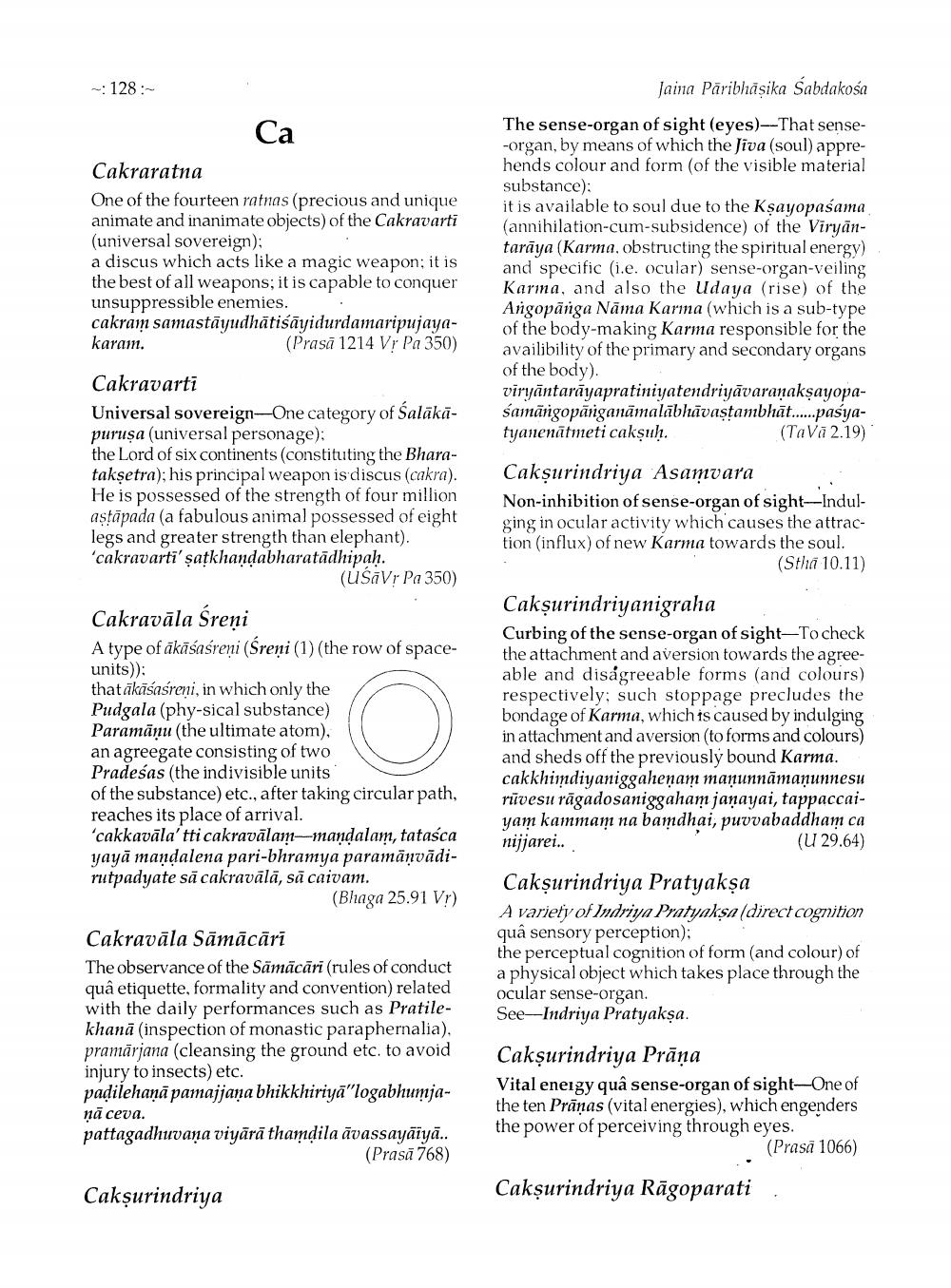________________
- 128
Cakraratna One of the fourteen ratnas (precious and unique animate and inanimate objects) of the Cakravarti (universal sovereign): a discus which acts like a magic weapon; it is the best of all weapons, it is capable to conquer unsuppressible enemies. cakram samastāyudhātiśāyidurdamaripujayakaram.
(Prasā 1214 V? Pa 350)
Jaina Pāribhāşika Sabdakosa The sense-organ of sight (eyes)--That sense-organ, by means of which the Jiva (soul) apprehends colour and form (of the visible material substance): it is available to soul due to the Kşayopasama (annihilation-cum-subsidence) of the Viryantarāya (Karma, obstructing the spiritual energy) and specific (i.e. ocular) sense-organ-veiling Karina, and also the Udaya (rise) of the Angopānga Nama Karma (which is a sub-type of the body-making Karma responsible for the availibility of the primary and secondary organs of the body). vīryāntarāyapratiniyatendriyāvaranakşayopasamangopārganāmalābhāvastambhāt......pasyatyanenātmeti cakṣuḥ.
(Tavā 2.19)
Cakravarti Universal sovereign-One category of Salākāpurusa (universal personage); the Lord of six continents (constituting the Bharatakşetra); his principal weapon is discus (cakra). He is possessed of the strength of four million astāpada (a fabulous animal possessed of eight legs and greater strength than elephant). 'cakravarti' satkhandabharatadhipah.
(uśáVr Pa 350)
Cakşurindriya Asamvara Non-inhibition of sense-organ of sight--Indulging in ocular activity which causes the attraction (influx) of new Karma towards the soul.
(Stha 10.11)
Cakravāla Sreņi A type of ākāśasreni (Śreni (1) (the row of spaceunits)): thatākasasreni, in which only the Pudgala (phy-sical substance) Paramāņu (the ultimate atom), an agreegate consisting of two Pradeśas (the indivisible units of the substance) etc., after taking circular path, reaches its place of arrival. 'cakkavāla' tti cakravālam-mandalam, tatasca yayā mandalena pari-bhramya paramānvādirutpadyate să cakravālā, sā caivam.
(Bhaga 25.91 Vr)
Cakşurindriyanigraha Curbing of the sense-organ of sight-To check the attachment and aversion towards the agreeable and disagreeable forms (and colours) respectively, such stoppage precludes the bondage of Karma, which is caused by indulging in attachment and aversion (to forms and colours) and sheds off the previously bound Karma. cakkhimdiyaniggaheṇam maņunnāmaņunnesu rūvesu rāgadosaniggaham janayai, tappaccaiyam kammam na bamdhai, puvvabaddham ca nijjarei..
(U 29.64)
Cakşurindriya Pratyakşa A variety of Indriya Pratyaksa (direct cognition quâ sensory perception); the perceptual cognition of form (and colour) of a physical object which takes place through the ocular sense-organ. See-Indriya Pratyakşa.
Cakravāla Sāmācārī The observance of the Sāmācāri (rules of conduct quâ etiquette, formality and convention) related with the daily performances such as Pratilekhanā (inspection of monastic paraphernalia), pramārjana (cleansing the ground etc. to avoid injury to insects) etc. padilehaņā pamajjana bhikkhiriyā"logabhumjaņā ceva. pattagadhuvana viyārā thamdila āvassayāiya..
(Prasā 768)
Cakşurindriya Prāņa Vital energy quâ sense-organ of sight-One of the ten Prāņas (vital energies), which engenders the power of perceiving through eyes.
(Prasā 1066)
Cakşurindriya
Cakşurindriya Rāgoparati.




